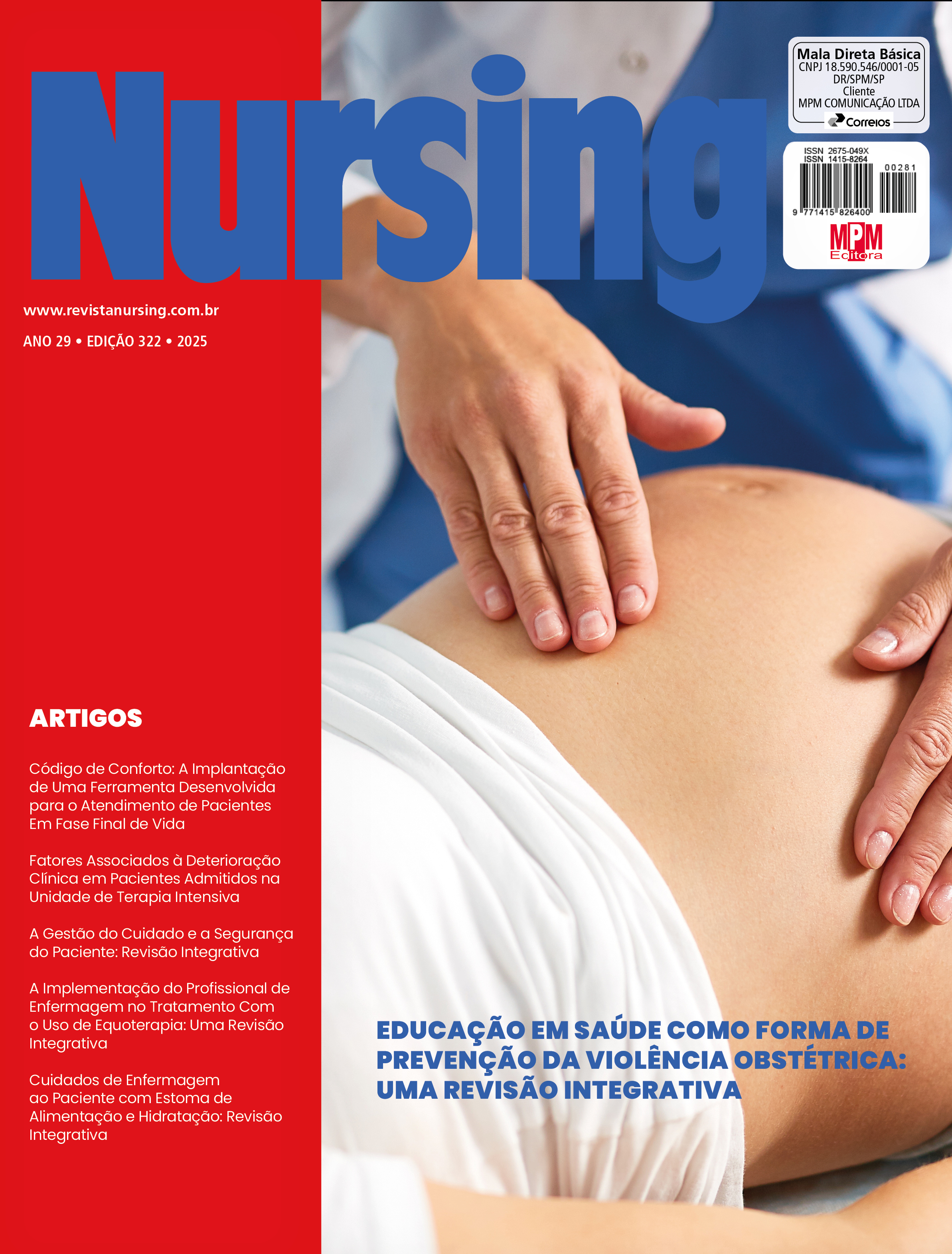Factors Associated with Clinical Deterioration in Patients Admitted to the Intensive Care Unit
DOI:
https://doi.org/10.36489/nursing.2025v29i322p10158-10163Keywords:
Risk factors, Clinical deterioration, Intensive care unitsAbstract
Objective: To evaluate the factors associated with clinical deterioration in patients admitted to the ICU. Method: Observational, quantitative study, carried out in 120 medical records of patients admitted between July and October 2023. For data collection, a sociodemographic and clinical characterization instrument and the NEWS 2 Scale were used. Statistical tests and a logistic regression model were applied, considering associations with p<0.05 as significant. Results: Factors such as advanced age (OR=6.9; 95%CI 1.78-26.7), cancer (OR=2.52; 95%CI 0.98-6.43), clinical hospitalization (OR=4.08; 95%CI 1.39-11.95), and death (OR=16.42; 95%CI 2.13-126.7) were associated with high NEWS 2 scores. Conclusion: Elderly patients, those diagnosed with cancer, and those hospitalized for clinical reasons have a higher risk of clinical deterioration in the ICU. The clinical outcome of death was more frequent among patients with high NEWS 2 scores
References
Miranda J de OF, Camargo CL de, Nascimento Sobrinho CL, Portela DS, Pinho P de S, Oliveira T de L. FACTORS ASSOCIATED WITH THE CLINICAL DETERIORATION RECOGNIZED BY AN EARLY WARNING PEDIATRIC SCORE. Texto & Contexto - Enfermagem. 2020;29. Available from: https://www.scielo.br/j/tce/a/8wwxZXyNVLWnNK9w538Bhwp/abstract/?lang=pt.
Oliveira APA de, Urbanetto J de S, Caregnato RCA. National Early Warning Score 2: transcultural adaptation to Brazilian Portuguese. Revista Gaúcha de Enfermagem. 2020;41.Avaiblable from: https://www.scielo.br/j/rgenf/a/Wc46R8wyJdLrGyffZQQQCcw/?format=pdf&lang=pt.
Dresser S, Teel C, Peltzer J. Frontline Nurses’ clinical judgment in recognizing, understanding, and responding to patient deterioration: A qualitative study. International Journal of Nursing Studies. 2023 Jan;139(1):104436. Available from: https://pubmed.ncbi.nlm.nih.gov/36731308/.
Fonseca MIH, de Almeida-Pititto B, Bensenor IM, Toth PP, Jones SR, Blaha MJ, et al. Changes in lipoprotein subfractions following menopause in the Longitudinal Study of Adult Health (ELSA-Brasil). Maturitas. 2019 Dec;130:32–7. Available from: https://pubmed.ncbi.nlm.nih.gov/31706433/.
Simushev AA, Medvedeva EYu, Shulpekova YuO, Nechaev VM, Skhirtladze MR, Popova IR, et al. Reassessment of disease severity routine laboratory tests in the COVID-19 infection. Russian Journal of Gastroenterology, Hepatology, Coloproctology. 2022 Mar 7;31(6):16–22. doi:10.22416/1382-4376-2021-31-6-16-22.
Vista do Análise de tendência de mortalidade por sepse no Brasil e por regiões de 2010 a 2019 [Internet]. Revistas.usp.br. 2022 [cited 2025 Mar 24]. Available from: https://www.revistas.usp.br/rsp/article/view/197372/181704.
Karabacak P, Bindal A, Turan İ, Erdemoglu E, Ceylan BG. The NEWS2 score predicts prolonged hospitalization in the intensive care unit in major surgery patients. Turkish Journal of Obstetrics and Gynecology [Internet]. 2023 Sep 1;20(3):179–83. Available from: https://www.ncbi.nlm.nih.gov/pmc/articles/PMC10478721/.
Zhang K, Zhang X, Ding W, Xuan N, Tian B, Huang T, et al. The Prognostic Accuracy of National Early Warning Score 2 on Predicting Clinical Deterioration for Patients With COVID-19: A Systematic Review and Meta-Analysis. Frontiers in Medicine [Internet]. 2021 Jul 9 [cited 2021 Nov 29];8:699880. Available from: https://www.ncbi.nlm.nih.gov/pmc/articles/PMC8298908/.
Gao Z, Fang L, Yin P, Deng Y, Pei M, Zhou T. Effects of Nursing Care for the Treatment of Patients with Bladder Cancer: A Systematic Review and Meta-analysis. Computational and mathematical methods in medicine [Internet]. 2022 Sep 25;2022:9554223. Available from: https://www.ncbi.nlm.nih.gov/pmc/articles/PMC9527440/.








